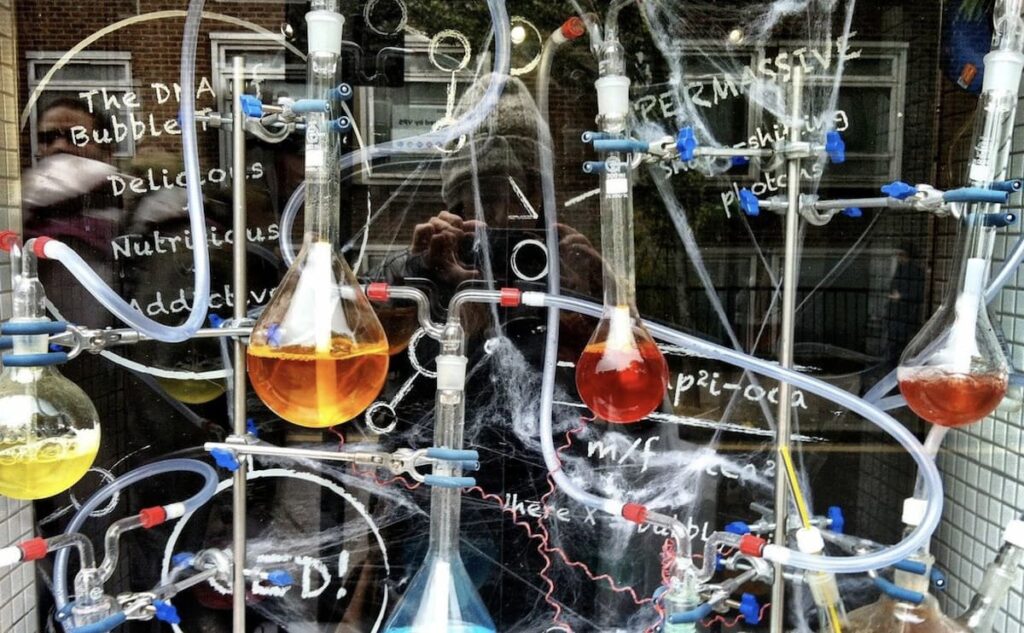The chemical phenomena (or chemical reactions) are those phenomena in which changes occur in matter, new substances called “products” are formed, and others called “reactive” are decomposed. For example: wood rot, paper burning, and composting.

chemical reactions can be spontaneous (reactions that occur without the need for energy or catalysts) or not spontaneous (reactions that need the input of energy, catalysts, or some external intervention for them to occur). Many times, for a reaction to happen, it is necessary for the reagents to have a specific temperature, a certain pH, a set pressure value, etc.
It may also be essential to control the speed at which chemical reactions occur. Catalysts are substances that are added to a chemical reaction to increase its rate, while inhibitors are substances that slow down chemical reactions. Other factors that affect the rate of a chemical reaction are temperature, pressure, the concentration of reactants, and the nature of the reaction itself.
Types of chemical phenomena
Chemical reactions can be:
inorganic reactions. Inorganic compounds are involved and can be classified according to:
- The direction in which the reaction occurs.
- reversible reactions. They go both ways, so the products can break down and re-form the reactants.

- irreversible reactions. They only happen one way.

- reversible reactions. They go both ways, so the products can break down and re-form the reactants.
- The type of particle that reacts.
- The reaction speed.
- Quick reactions. They happen in a very short time.

- Slow reactions. They take a long time to complete.

- Quick reactions. They happen in a very short time.
- The form of energy it emits or absorbs.
- Exothermic reactions. As they occur, they release heat.

- Endothermic reactions. As they occur, they absorb heat.

- Exoluminous reactions. When they occur, they emit light.

- endoluminal reactions. To occur, they need light.

- Exothermic reactions. As they occur, they release heat.
- The type of transformation.
- Synthesis or addition reactions. Two substances combine to form a new substance.

- Decomposition reactions. One or more substances are broken down into their simplest constituents.

- Displacement or substitution reactions. One element or compound replaces another in a compound, releasing it.

- Double substitution reactions. Two compounds exchange elements or compounds at the same time.

- Synthesis or addition reactions. Two substances combine to form a new substance.
Organic reactions. They are reactions involving organic compounds. They have many classifications based on the type of organic compound that reacts and the type of reaction that it undergoes. Some examples are:
- Halogenation of alkanes. A hydrogen of an alkane is replaced by a halogen.

- alkane combustion. An alkane reacts with oxygen to generate carbon dioxide and water if combustion is complete.

- Halogenation of alkenes. Halogens replace one or both hydrogens of the carbons involved in the double bond.

- Hydrogenation of alkenes. Hydrogens are added to the carbons involved in the double bond to form the corresponding alkane.

Importance of chemical phenomena
Many chemical phenomena sustain the life of living things, such as digestion in humans and animals, photosynthesis in plants, and respiration in both.
Another important chemical process, especially in the life of microorganisms, is fermentation, which is usually used to manufacture foods such as cheeses, yogurts, wines, and beers.
All the increase and the development of a living being involves chemical reactions that occur in it, sometimes stimulated by certain environmental conditions.
Examples of chemical phenomena
Around us, there are numerous cases of chemical phenomena or processes that include:
- Wood rot
- Burning paper
- Antibiotic resistance of bacteria
- Milk that turns sour
- Disinfection of a wound with alcohol
- Use of fruit salt to combat heartburn
- Burning a candle
- Blood clotting
- Muscle fatigue after intense exercise
- The killing of insects by insecticides
- Obtaining Roquefort cheese
- obtaining cider
- obtaining yogurt
- composting
- Ensilage
- Obtaining bioethanol from molasses
- Bloated cans of preserves
- Rotten egg
- Rusting of a fence
- Obtaining biodiesel from palm oil
Chemical phenomena in the industry
Certain chemical phenomena are also vital in the industry. To begin with, the combustion of hydrocarbons (such as gasoline, diesel, or kerosene) produces energy to run the machinery that handles countless industrial processes.
On the other hand, the steel industry, paper, plastics, construction materials, paints, drugs, agricultural products, etc., are based on various chemical phenomena such as galvanization, electrolysis, and many others.
The generation of new energy sources (such as biodiesel and bioethanol) is also based on this type of phenomenon.
The transformation of energy
In chemical phenomena, it is common for there to be energy transformation. For example, when the chemical energy contained in the bonds of a specific molecule is transformed into electrical energy or released as heat (this occurs in exothermic phenomena, such as when hydrochloric acid is mixed with zinc), there is an energy transformation. The same happens when light energy is captured and transformed into chemical energy.
Some chemical processes need heat to be carried out and are called “endothermic.” Others require the presence of catalysts or cofactors.

















